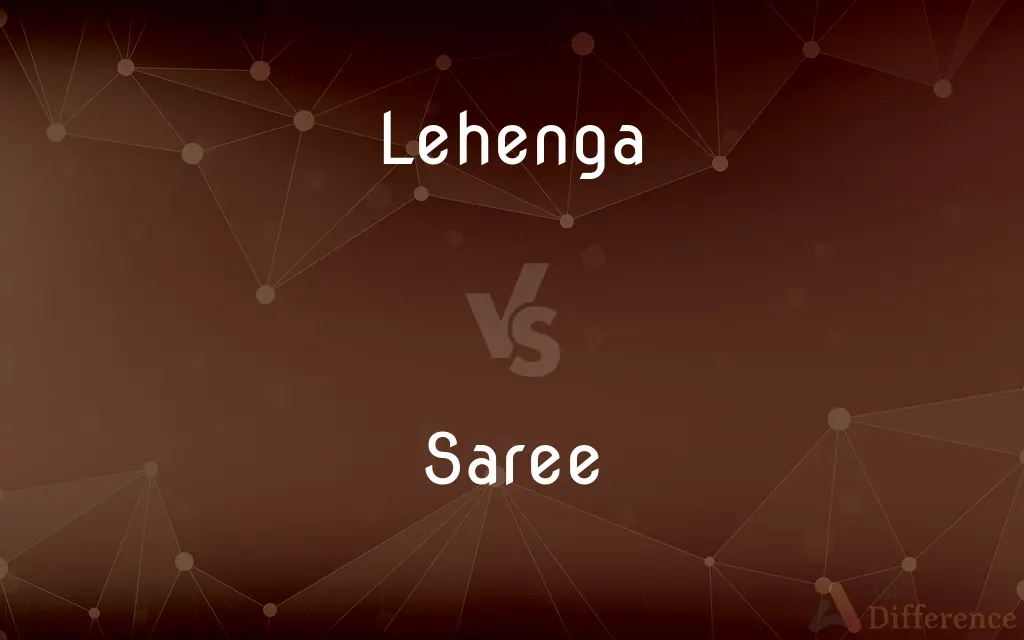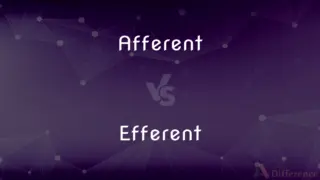Lehenga vs. Saree — What's the Difference?
By Tayyaba Rehman & Urooj Arif — Updated on May 8, 2024
A lehenga is a long, flared skirt worn with a blouse and dupatta, often for special occasions. A saree is a long, unstitched fabric draped around the body, typically with a blouse and petticoat.

Difference Between Lehenga and Saree
Table of Contents
ADVERTISEMENT
Key Differences
Lehenga is a traditional skirt usually paired with a matching blouse and dupatta (scarf), forming a coordinated outfit. The saree, by contrast, is a long, unstitched fabric (usually 5-9 yards) draped around a blouse and petticoat.
Lehenga outfits are pre-stitched, making them quicker to wear, while a saree requires specific draping techniques that vary by region.
Lehenga styles are often more elaborate, suitable for weddings and festivals. Saree designs vary widely, ranging from daily wear to sophisticated bridal attire.
Lehenga styles offer greater comfort and ease of movement due to the skirt's flexibility. Saree draping, on the other hand, can be restrictive but is often more graceful.
Comparison Chart
Structure
Pre-stitched skirt, blouse, and dupatta
Unstitched fabric draped around blouse
ADVERTISEMENT
Draping Method
Worn directly like a skirt
Wrapped and draped around the body
Styling
Coordinated matching sets
Various draping styles based on regions
Use
Common for weddings and festivals
Suitable for casual to formal occasions
Movement
More comfortable and flexible
Restrictive but graceful
Compare with Definitions
Lehenga
A traditional skirt worn with a blouse and scarf.
She wore a bright red lehenga at her cousin's wedding.
Saree
An unstitched fabric wrapped around the body.
She learned to drape a saree from her grandmother.
Lehenga
Offers ease of movement compared to sarees.
The lehenga allowed her to dance comfortably all night.
Saree
Usually accompanied by a blouse and petticoat.
The blouse and petticoat helped secure the saree in place.
Lehenga
Often pre-stitched for ease of wear.
The lehenga was easy to wear with a simple drawstring waistband.
Saree
Different draping styles exist across regions.
She wore a saree in the Bengali style at the Durga Puja festival.
Lehenga
Comes in elaborate styles for weddings and celebrations.
Her bridal lehenga was adorned with gold embroidery.
Saree
Can be restrictive but exudes elegance.
The saree gave her a graceful appearance during the ceremony.
Lehenga
Paired with a matching blouse and dupatta.
The dupatta draped over her shoulder completed the lehenga set.
Saree
Ranges from casual cotton to luxurious silk designs.
Her cotton saree was ideal for everyday wear.
Lehenga
The lehenga, lehnga or langa (also known as a ghagra or gagra, chaniya, pavadai, or lacha) is a form of ankle-length skirt from the Indian subcontinent. Different patterns and styles of traditional embroidery are used to decorate the lehenga.
Saree
Variant of sari.
Lehenga
A long skirt worn by women in South Asia that is often elaborately embroidered with beads, shisha mirrors, or other ornaments.
Saree
The principal garment of a Hindoo woman. It consists of a long piece of cloth, which is wrapped round the middle of the body, a portion being arranged to hang down in front, and the remainder passed across the bosom over the left shoulder.
Lehenga
A two-piece garment consisting of this skirt and a choli. In this sense, also called lehenga choli.
Saree
A dress worn primarily by Hindu women; consists of several yards of light material that is draped around the body
Common Curiosities
What occasions are lehengas best for?
Lehengas are popular for weddings, festivals, and celebrations.
Are lehengas always worn with a dupatta?
Yes, a dupatta is usually included for modesty and styling.
What fabrics are used for sarees?
Sarees can be made of cotton, silk, chiffon, and more.
Are lehengas or sarees easier to wear?
Lehengas are pre-stitched and easier to wear, while sarees require draping.
Can lehengas be worn for daily activities?
Typically not, as they are more suitable for special occasions.
Do sarees always need ironing?
Not always, as some fabrics, like chiffon, are wrinkle-resistant.
Are sarees worn the same way everywhere?
No, different regions have unique saree draping styles.
Can sarees be worn without a blouse and petticoat?
Usually, no, as these garments help secure the saree.
Is there a standard length for sarees?
Typically 5-9 yards, but regional preferences vary.
Do sarees come in ready-made styles?
Pre-stitched sarees exist but are less common.
Do lehengas come in different styles?
Yes, such as A-line, circular, and mermaid-cut lehengas.
Is draping a saree challenging?
It can be, but practice and regional techniques make it easier.
Can lehengas have variations in skirts?
Yes, they come in different cuts and embellishments.
Is one more traditional than the other?
Both are traditional, with regional and cultural significance.
Can a lehenga be customized?
Yes, many lehengas can be custom-made for color and style.
Share Your Discovery

Previous Comparison
Disclosure vs. Discloser
Next Comparison
Afferent vs. EfferentAuthor Spotlight
Written by
Tayyaba RehmanTayyaba Rehman is a distinguished writer, currently serving as a primary contributor to askdifference.com. As a researcher in semantics and etymology, Tayyaba's passion for the complexity of languages and their distinctions has found a perfect home on the platform. Tayyaba delves into the intricacies of language, distinguishing between commonly confused words and phrases, thereby providing clarity for readers worldwide.
Co-written by
Urooj ArifUrooj is a skilled content writer at Ask Difference, known for her exceptional ability to simplify complex topics into engaging and informative content. With a passion for research and a flair for clear, concise writing, she consistently delivers articles that resonate with our diverse audience.
















































